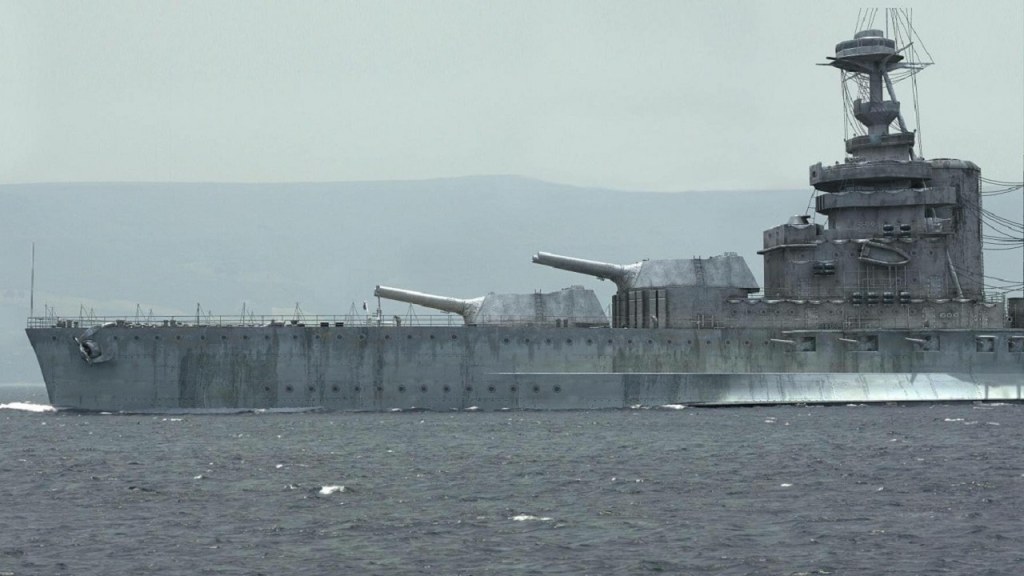Unleashing The Power: Discover The Majesty Of The Queen Elizabeth Class Battleships!
The Mighty Queen Elizabeth Class Battleships: A Marvel of Naval Power
Introduction
Dear Queen Elizabeth Admirer,
2 Picture Gallery: Unleashing The Power: Discover The Majesty Of The Queen Elizabeth Class Battleships!


Welcome to the world of naval supremacy and the awe-inspiring Queen Elizabeth Class Battleships. These majestic vessels have left an indelible mark on maritime history, showcasing the power and might of the British Royal Navy. In this article, we will delve into the fascinating world of these battleships, exploring their construction, capabilities, and impact on naval warfare.

Image Source: 19fortyfive.com
So, fasten your seatbelts and prepare to be amazed by the grandeur and prowess of the Queen Elizabeth Class Battleships!
What are Queen Elizabeth Class Battleships?
🔍 Queen Elizabeth Class Battleships refer to a series of advanced warships built for the British Royal Navy. These formidable vessels are the largest and most powerful warships ever constructed for the Royal Navy, designed to operate in both traditional warfare and modern conflicts.

Image Source: ytimg.com
📜 The Queen Elizabeth Class Battleships boast a displacement of approximately 65,000 tons, making them one of the most massive warships in the world. They are equipped with state-of-the-art weaponry, advanced command and control systems, and cutting-edge technology to dominate the seas.
🏭 These battleships were constructed at various shipyards in the United Kingdom, showcasing the country’s prowess in naval engineering and manufacturing. The lead ship of the class, HMS Queen Elizabeth, was commissioned in 2017, followed by its sister ship, HMS Prince of Wales, in 2019.
🌍 The Queen Elizabeth Class Battleships serve as a symbol of British naval power and are an integral part of the United Kingdom’s defense strategy, projecting influence and ensuring national security.
💂♂️ Onboard these warships, a crew of thousands works tirelessly to operate the ship’s systems, maintain its readiness, and execute missions across the globe.
🗺️ These battleships are designed to be versatile, capable of undertaking a wide range of operations, including anti-submarine warfare, air defense, and power projection.
Who Operates the Queen Elizabeth Class Battleships?
👮♂️ The Queen Elizabeth Class Battleships are operated by the British Royal Navy. As the pride of the Royal Navy, these vessels are a testament to the naval heritage and traditions of the United Kingdom.
👑 Serving as a symbol of national strength and defense, these battleships are at the forefront of the Royal Navy’s capabilities, projecting power and protecting British interests around the globe.
🚀 The crew of these battleships consists of highly skilled and dedicated sailors, officers, and marines who undergo rigorous training to ensure the smooth operation and combat readiness of the ships.
🎖️ These sailors and officers, known for their professionalism and expertise, are the backbone of the Royal Navy and play a crucial role in maintaining the security of the United Kingdom and its allies.
When Were the Queen Elizabeth Class Battleships Commissioned?
⏰ The first Queen Elizabeth Class Battleship, HMS Queen Elizabeth, was commissioned on December 7, 2017. This marked a significant milestone for the Royal Navy, as it signified the return of aircraft carriers to British naval operations after a gap of almost a decade.
⚓ HMS Prince of Wales, the second vessel of the class, was commissioned on December 10, 2019, further strengthening the Royal Navy’s capabilities.
🚢 These dates serve as a testament to the dedication and hard work of the shipbuilders, engineers, and sailors who contributed to the construction and commissioning of these magnificent warships.
Where are the Queen Elizabeth Class Battleships Based?
🌍 The Queen Elizabeth Class Battleships are primarily based at HMNB Portsmouth, a key naval base in the United Kingdom. This strategic location provides easy access to the Atlantic Ocean, the Mediterranean Sea, and other critical regions for naval operations.
🏴 Port of Portsmouth, located on the south coast of England, has a rich naval history and serves as a hub for British maritime operations. It provides the necessary facilities and infrastructure to support the maintenance, logistics, and deployment of these battleships.
🛳️ These battleships, with their immense size and capabilities, can also operate from other naval bases and international waters, ensuring the United Kingdom’s ability to project power and protect its interests worldwide.
Why are the Queen Elizabeth Class Battleships Significant?
🌟 The Queen Elizabeth Class Battleships symbolize the United Kingdom’s commitment to maintaining a powerful and capable navy. Their significance lies in the enhanced capabilities they bring to the Royal Navy and the country as a whole.
🔱 These battleships provide a platform for power projection, allowing the United Kingdom to project its influence and protect its interests in an increasingly complex and uncertain global environment.
🔒 The Queen Elizabeth Class Battleships also play a vital role in ensuring the security of international trade routes, safeguarding the free flow of goods and resources upon which the global economy depends.
🌐 Additionally, these battleships serve as a symbol of national pride and technological prowess, showcasing the United Kingdom’s ability to design, construct, and operate world-class warships.
💼 Furthermore, the construction and operation of these battleships have significant economic benefits, generating employment opportunities and supporting various industries throughout the United Kingdom.
🌊 The Queen Elizabeth Class Battleships represent a strategic asset for the United Kingdom, providing the country with the means to protect its sovereignty, contribute to international security, and project power globally.
How are the Queen Elizabeth Class Battleships Constructed?
🔨 The construction of the Queen Elizabeth Class Battleships involved a combination of traditional shipbuilding techniques and cutting-edge technology.
🏗️ These warships were built in sections at different shipyards across the United Kingdom, with each section being transported to the final assembly site for integration.
⚙️ The construction process required the coordination of various stakeholders, including shipbuilders, engineers, designers, and naval architects, to ensure the seamless integration of systems and components.
🔩 Advanced computer-aided design and manufacturing techniques were employed to optimize the ships’ performance, reduce construction time, and enhance overall efficiency.
📐 The design of the Queen Elizabeth Class Battleships incorporates stealth features, such as a low radar cross-section and a minimized infrared signature, to enhance survivability and reduce the risk of detection.
🔬 Rigorous testing and evaluation processes were conducted throughout the construction phase to validate the ships’ performance, ensuring they meet the stringent requirements of the Royal Navy.
🚢 The result of these efforts is a fleet of battleships that exemplify the pinnacle of naval engineering and technology, ready to face the challenges of the 21st century.
Advantages and Disadvantages of the Queen Elizabeth Class Battleships
👍 Advantages:
1. Unmatched Power: The Queen Elizabeth Class Battleships possess immense firepower, making them a formidable force on the seas. They can project force over long distances and engage multiple targets simultaneously.
2. Versatility: These battleships are designed for multi-role operations, capable of conducting a wide range of missions, including air defense, anti-submarine warfare, power projection, and humanitarian assistance.
3. Enhanced Survivability: The Queen Elizabeth Class Battleships incorporate advanced defensive systems and technologies to enhance survivability, protecting the ship and its crew from various threats.
4. Global Reach: With their long-range capabilities, these battleships can deploy to any part of the world, ensuring the United Kingdom’s presence and influence in strategic regions.
5. Technological Superiority: The Queen Elizabeth Class Battleships leverage cutting-edge technology and systems, providing the Royal Navy with a significant advantage over potential adversaries.
👎 Disadvantages:
1. Cost: The construction and operation of these battleships involve significant financial investments. The expense of building and maintaining such complex vessels can strain defense budgets.
2. Vulnerability to New Threats: Rapid advancements in technology and the emergence of new threats pose challenges to the long-term viability of these battleships. Continuous upgrades and adaptations are required to address evolving threats.
3. Limited Maneuverability: Due to their size and displacement, the Queen Elizabeth Class Battleships may face limitations in maneuverability, particularly in narrow or shallow waters.
4. Dependency on Support Infrastructure: These battleships rely on a network of support infrastructure, including naval bases, logistics facilities, and maintenance capabilities. Disruptions to this infrastructure could impact their operational readiness.
5. Environmental Impact: The operation of these battleships, like any large naval vessel, has an environmental footprint. Steps must be taken to mitigate and minimize any adverse effects.
Frequently Asked Questions (FAQs)
1. What is the length of the Queen Elizabeth Class Battleships?
The Queen Elizabeth Class Battleships have an overall length of approximately 280 meters.
2. How many aircraft can the battleships carry?
These battleships can carry a mix of up to 40 aircraft, including fixed-wing jets and helicopters.
3. Can the Queen Elizabeth Class Battleships operate nuclear-powered submarines?
No, these battleships are not equipped to accommodate or operate nuclear-powered submarines.
4. Are the battleships capable of conducting amphibious operations?
While they are not primarily designed for amphibious operations, the Queen Elizabeth Class Battleships can support such missions by launching and recovering landing craft and providing command and control capabilities.
5. How long does it take to build a Queen Elizabeth Class Battleship?
The construction of a Queen Elizabeth Class Battleship takes several years, with various stages of planning, design, and assembly involved.
Conclusion
🎉 In conclusion, the Queen Elizabeth Class Battleships stand as a testament to the British Royal Navy’s commitment to naval supremacy and global security. These marvels of engineering combine advanced technology, formidable firepower, and strategic versatility to project power and protect the United Kingdom’s national interests.
🌟 As we have explored in this article, their construction, capabilities, and impact on naval warfare make them an indispensable asset for the Royal Navy.
✨ So, whether you are a history enthusiast or a maritime aficionado, the Queen Elizabeth Class Battleships are sure to captivate your imagination and leave you in awe of their sheer magnificence.
⚓️ Now, it’s up to us to appreciate and support these battleships, ensuring that they continue to serve and defend our proud nation for years to come.
Final Remarks
Dear Reader,
Thank you for taking the time to explore the world of the Queen Elizabeth Class Battleships. This article has aimed to provide you with a comprehensive understanding of these magnificent warships, their significance, and their impact on maritime history.
Please note that the information presented in this article is accurate to the best of our knowledge. However, naval technology and operations are constantly evolving, and new developments may have taken place since the publication of this article.
We hope that you have found this article informative and engaging. If you have any further questions or would like to delve deeper into the world of naval warfare, we encourage you to seek additional resources and continue your exploration.
Happy reading and bon voyage!
This post topic: Queen Elizabeth
